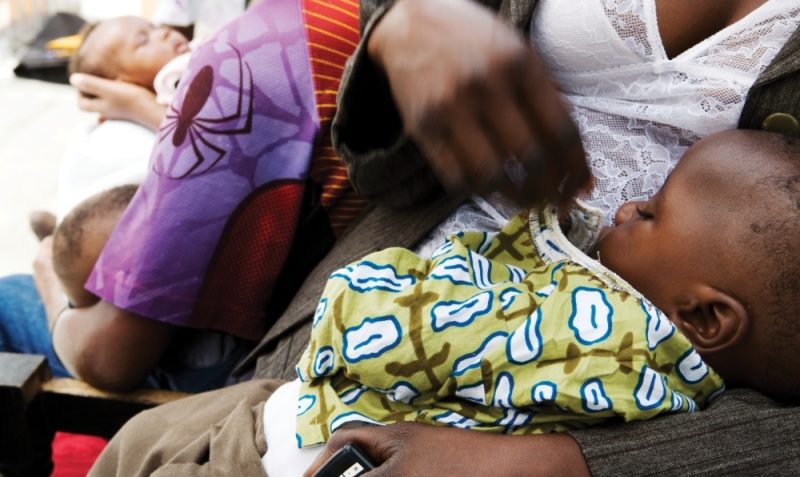Making Busia a safer place for adolescent girls
 © Nell Freeman for Frontline AIDS
© Nell Freeman for Frontline AIDS
With Busia's teenage pregnancy rate at 30%, CYRSA-Uganda is working to empower women against transactional sex in this border town.
Luisa Orza is the SRHR Technical Lead at International HIV/AIDS Alliance. This blog was co-written with Allen Kyendikuwa, Acting Team Leader at CYSRA-Uganda, and Lorine Anyango, Coordinator of the Busia Network of Adolescent and Young Mothers.
Busia is a bustling border town where pink-shirted bicycle riders ferry people and goods to and from neighbouring Kenya. The combination of a transient, cash-equipped population, the stopping point for long distance truckers, and a relative lack of jobs and services are contributing factors to a high HIV prevalence rate in this part of Uganda.
Many local girls and young women come from conservative, rural homes, where early marriage and child-bearing are commonplace, money is scarce and conversations between parents and their girl children on sex and sexuality are virtually non-existent. The school curriculum doesn’t effectively teach girls how to navigate sexual relationships, it doesn’t equip them with a language of negotiation and consent, nor does it adequately provide them with the tools to protect their long-term interests.
Those who do venture across the threshold of the local family planning or sexual and reproductive health clinic may find themselves being scolded by unfriendly health workers.
The cash economy of the border promises quick and easy access to material things: clothes, make up, menstrual hygiene products, school books and status, in other words: transactional sex.
An estimated one-in-four girls between 15 and 19 in Uganda experience pregnancy, with this comes exposure to HIV, the consequences of unsafe abortion (approximately 800 unsafe abortions take place daily in Uganda, resulting in some 6,000 deaths a year), or exclusion from education, social marginalisation, and a reduction in future employment and livelihood options. Families see teenage mums as a burden, and these girls risk entering into a cycle of exclusion and poverty which may lead to a reliance on transactional relationships, vulnerability to violence, further unintended pregnancies, onward transmission of HIV and STIs, and chronic ill-health – both mental and physical.
Estimated at 30%, Busia’s teenage pregnancy rate is even higher than the national average, but the Uganda Youth Coalition on SRHR and HIV/AIDS (CYSRA-Uganda) is working to change the outlook for adolescent and young mothers. CYRSA is part of our Partnership to Inspire, Transform and Connect the HIV response (PITCH) programme. CYSRA is bringing the voices, visions and priorities of adolescent girls and young women to the attention of decision-makers at all levels, from families to global policy fora.
“Adolescent mothers need a sense of belonging. Many times they are chased away from their homes and yet their partners are not willing to take responsibility. We support, empower and equip them with survival and advocacy skills to ensure they can increase the uptake of contraception, ably negotiate with their parents to take them back to school, and reduce stigma towards adolescent mothers in the communities they live.” – Allen Kyendikuwa, Acting Team Leader, CYSRA-Uganda.
CYSRA’s work is focused on empowering adolescent girls and young women to advocate for their needs and rights in relation to HIV and sexual and reproductive health and rights (SRHR). And CYSRA supports a newly formed Busia Network of Adolescent and Young Mothers. The network currently comprises 13 member associations or support groups who meet to share the challenges and experiences of raising children as young mothers. Common among the issues faced by adolescent and young mothers are barriers to returning to school, the challenge of providing their children with a nutritious diet, and the need for economic empowerment or income generation.
These issues speak strongly to the aims of the 2030 Agenda for Sustainable Development, which recognise the indivisibility of many issues and set out a framework of interdependent goals and targets for addressing them. Among these are girls’ education, women’s equal employment and economic independence, universal access to sexual and reproductive health and the enjoyment of reproductive rights. The recent Family Planning Summit served to reframe the FP2020 targets to ensure 120 million women newly accessing and using modern methods of family planning within the context of the SDGs.
The Busia Network representatives work with members of the community, including parents and guardians, schools and religious leaders to change mindsets, highlight the needs of young mothers, and act as role models to other girls and young women.
“Peer support has proven effective in improving the emotional stability of adolescent mothers. This translates to improved demand for reproductive health services and sharing ideas about improving our livelihoods.”- Lorine Anyango, Coordinator of the Busia Network of Adolescent and Young Mothers.
Global commitments and targets can seem abstract and removed from the everyday experience of individuals and communities. Yet the example of the Busia Network of Adolescent and Young Mothers shines a light on the reality of how these goals and targets intersect and underpin each other. If the network’s goals and ambitions are realised, the busy, bustling, border town of Busia will be a safer place for adolescent girls and young women to make informed choices about their SRHR, remain free from or live well with HIV, and be valued citizens whose contribution to the local economy and society is recognised.
This article was written as the International HIV/AIDS Alliance, before we changed our name to Frontline AIDS.
Tags
Adolescent girls and young womenPITCHSexual and reproductive health and rights (SRHR)Uganda


